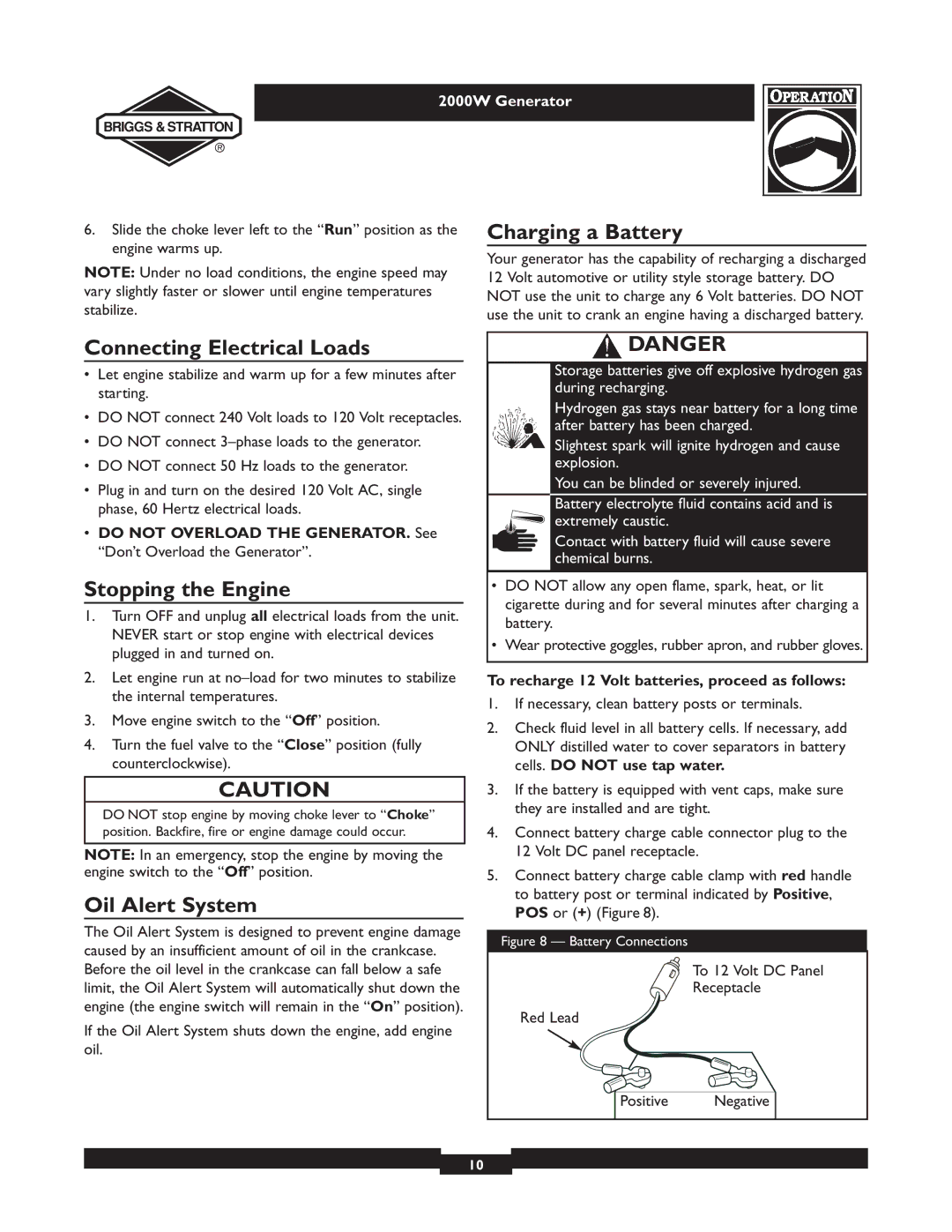
2000W Generator
6.Slide the choke lever left to the “Run” position as the engine warms up.
NOTE: Under no load conditions, the engine speed may vary slightly faster or slower until engine temperatures stabilize.
Charging a Battery
Your generator has the capability of recharging a discharged 12 Volt automotive or utility style storage battery. DO NOT use the unit to charge any 6 Volt batteries. DO NOT use the unit to crank an engine having a discharged battery.
Connecting Electrical Loads
•Let engine stabilize and warm up for a few minutes after starting.
•DO NOT connect 240 Volt loads to 120 Volt receptacles.
•DO NOT connect
•DO NOT connect 50 Hz loads to the generator.
•Plug in and turn on the desired 120 Volt AC, single phase, 60 Hertz electrical loads.
•DO NOT OVERLOAD THE GENERATOR. See “Don’t Overload the Generator”.
Stopping the Engine
1.Turn OFF and unplug all electrical loads from the unit. NEVER start or stop engine with electrical devices plugged in and turned on.
2.Let engine run at
3.Move engine switch to the “Off” position.
4.Turn the fuel valve to the “Close” position (fully counterclockwise).
CAUTION
DO NOT stop engine by moving choke lever to “Choke” position. Backfire, fire or engine damage could occur.
NOTE: In an emergency, stop the engine by moving the engine switch to the “Off” position.
Oil Alert System
The Oil Alert System is designed to prevent engine damage caused by an insufficient amount of oil in the crankcase. Before the oil level in the crankcase can fall below a safe limit, the Oil Alert System will automatically shut down the engine (the engine switch will remain in the “On” position).
If the Oil Alert System shuts down the engine, add engine oil.
![]() DANGER
DANGER
Storage batteries give off explosive hydrogen gas during recharging.
Hydrogen gas stays near battery for a long time after battery has been charged.
Slightest spark will ignite hydrogen and cause explosion.
You can be blinded or severely injured.
Battery electrolyte fluid contains acid and is extremely caustic.
Contact with battery fluid will cause severe chemical burns.
•DO NOT allow any open flame, spark, heat, or lit cigarette during and for several minutes after charging a battery.
•Wear protective goggles, rubber apron, and rubber gloves.
To recharge 12 Volt batteries, proceed as follows:
1.If necessary, clean battery posts or terminals.
2.Check fluid level in all battery cells. If necessary, add ONLY distilled water to cover separators in battery cells. DO NOT use tap water.
3.If the battery is equipped with vent caps, make sure they are installed and are tight.
4.Connect battery charge cable connector plug to the 12 Volt DC panel receptacle.
5.Connect battery charge cable clamp with red handle to battery post or terminal indicated by Positive, POS or (+) (Figure 8).
Figure 8 — Battery Connections
| To 12 Volt DC Panel |
| Receptacle |
Red Lead |
|
Positive | Negative |
10
